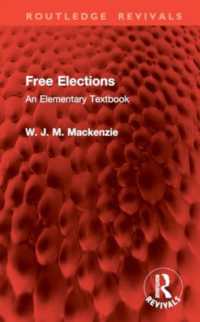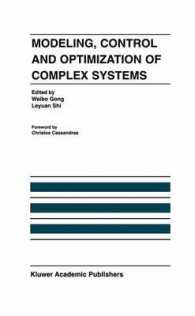Full Description
This well-written overview of the major theoretical perspectives and crime types covered in most introductory criminology courses covers the most up-to-date theories and research of the field in a concise, cost-effective format. Each chapter includes chapter-opening vignettes, photos, case studies, and tables and figures to engage student interest. In the often-difficult theory chapters, summary tables that compare and contrast theories and Concluding Policy and Prevention sections promote a deep understanding of criminological concepts.New to this edition:An all-new Chapter 5, Crime as Choice: Rationality, Emotion, and Criminal Behavior, covers rational choice, routine activities, and cultural/anarchic theories, enabling a discussion of the role of emotions in criminality. A new discussion explores the positive and negative aspects of emotions The Theory in Action boxes illustrate chapter material with interesting case studies and now include review questions. All chapters have been thoroughly updated with the new events in crime and criminology, as well as the latest crime statistics and empirical advances. Fascinating new case studies featuring major criminals illustrate the theories. New, expanded coverage of drug trafficking, human trafficking, weapons trafficking, money laundering, and school shootings has been added. New tables with updated data and illustrations appear in every chapter.
Contents
PrefaceCHAPTER 1Criminology? What is Crime? Criminality An Excursion Through the American Criminal Justice System A Short History of Criminology The Role of Theory in Criminology Ideology in Criminological Theory Connecting Criminology Theory and Social PolicyCHAPTER 2: Measuring Crime and Criminal Behavior Categorizing and Measuring Crime and Criminal Behavior The Uniform Crime Reports: Counting Crime Officially NIBRS: The "New and Improved" UCR Crime Victimization Survey Data and Their Problems Areas of Agreement between the UCR and NCVS Self-Report Crime Surveys and Their Problems White-Collar Crime: The FBI's Financial Crimes Report The Dark Figure of Crime What Can We Conclude About the Three Main Measures of Crime in AmericaCHAPTER 3: Victimology: Exploring the Experience of Victimization The Emergence of Victimology Who Gets Victimized? Victimization in the Workplace Victimization in the Schools Human Trafficking Sexual Assault of Children: Who Gets Victimized? Domestic Violence Victimization Identity Theft and Other Forms of Cybervictimization Theory in Action: A Case of Cybervictimization and Its Consequences Victimization Theories Is Victimology "Blaming the Victim?" The Consequences of Victimization Victimization and the Criminal Justice System Victim-Offender Reconciliation Programs (VORPS)CHAPTER 4: The Early Schools of Criminology Preclassical Notions of Crime and Criminals The Classical School: The Calculating Criminal The Rise of Positivism Theory in Action: Giuseppe Villella: Atavism, Ideology, and Racism Deterrence and Choice: Pain versus Gain Evaluation of the Classical and Early Positivist Schools Policy and Prevention: Implications of Deterrence TheoriesCHAPTER 5: Crime as Choice: Rationality, Emotion, and Criminal Behavior Returning to Classic Assumptions of Human Nature Rational Choice Theory Cultural Criminology Theory in Action: "Slick Willie" Sutton-"Where the Money Is" Emotions and Their Functions Policy and Prevention: Implications of Rational Choice and Routine Activities Theories Policy and Prevention: Implications of Cultural CriminologyCHAPTER 6: Social Structural Theories The Social Structural Tradition The Chicago School of Ecology Social Disorganization Evaluation of Social Ecology/Social Disorganization Theory The Anomie/Strain Tradition Extending Anomie: Subcultural Theories Theory in Action: Anthony and Nathaniel Cook and Oppositional Culture Street Gangs Today Evaluation of the Anomie/Strain and Subcultural Tradition Policy and Prevention: Implications of Social Structural TheoriesCHAPTER 7: Social Process Theories The Social Process Tradition Differential Association Theory Social Learning Theory The Social Control Tradition Theory in Action: Lionel Tate and Social- and Self-Control Sykes and Matza's Neutralization Theory Policy and Prevention: Implications of Social Process TheoriesCHAPTER 8: Critical and Feminist Theories The Conflict Perspective of Society Karl Marx and Revolution Conflict Theory: Max Weber and Power and Conflict Peacemaking Criminology Evaluation of Critical Theories Policy and Prevention: Implications of Critical Theories Feminist Criminology Theory in Action: Revolutionary Marxism, Gender Fluidity, and Patty Hearst Evaluation of Feminist Theories Policy and Prevention: Implications of Feminist TheoriesCHAPTER 9: Psychosocial Theories: Individual Traits and Criminal Behavior The Two "Great Pillars of Psychology" Intelligence The IQ/Crime Connection Temperament and Personality Glen Walters' Lifestyle Theory The Antisocial Personalities Theory in Action: Evil Minds: The Spahalski Twins Evaluation of the Psychosocial Perspective Policy and Prevention: Implications of Psychosocial TheoriesCHAPTER 10. Biosocial Approaches The Biosocial Approach Behavior Genetics Molecular Genetics The Neurosciences Theory in Action: Genetics and Neuroscience in Court: The Brian Dugan Case Evolutionary Psychology Other Biosocial Risk Factors for Criminality Evaluation of the Biosocial Perspective Policy and Prevention: Implications of Biosocial Theories CHAPTER 11: Developmental Theories: From Delinquency to Crime to Desistance The Developmental Perspective: Continuity and Change Risk and Protective Factors for Serious Delinquency Major Developmental Theories Theory in Action: Jimmy Boyle, From Underworld Hero to Art Celebrity Evaluation of Development Theories Policy and Prevention: Implications of Developmental Theories CHAPTER 12: Crimes of Violence Violence in History Murder Mass, Spree, and Serial Murder Theory in Action: Gary Ridgway, America's Most Prolific Serial Killer Rape Robbery Aggravated Assault Gun Violence Theories of Violence CHAPTER 13: Terrorism What is Terrorism? Is There a Difference Between Terrorists and Freedom Fighters? The Extent of Terrorism Al-Qaeda Hezbollah Domestic Terrorism Other Domestic Groups Theory in Action: Timothy McVeigh and the Oklahoma Bombing Is There a Terrorist Personality? Terrorism and Common Crime Theories of Terrorism Law Enforcement Response and Government PolicyCHAPTER 14. Property Crime What is a Property Offense? Larceny-Theft Burglary Theory in Action: Colton Harris-Moore, the Barefoot Bandit Motor Vehicle Theft Arson Crimes of Guile and Deceit: Embezzlement, Fraud, and Forgery/CounterfeitingCHAPTER 15: Public Order Crime What Are Public Order Crimes? Alcohol and Crime Theory in Action: What "Happy Drunks" Cost Society: The Case of Henry Earl Illegal Drugs and Crime Prostitution and Commercialized ViceCHAPTER 16: White-Collar Crime The Concept of White-Collar Crime Occupational Crime Corporate Crime Theory in Action: Ponzi Schemes from Charles Ponzi to Bernie Madoff Cybercrime: Oh, What a Tangled World Wide Web We Weave!CHAPTER 17: Organized Crime What is Organized Crime? Political Corruption and Organized Crime A Brief History of Organized Crime in the United States Affirming the Existence of Organized Crime Other Organized Crime Groups Theory in Action: James "Whitey" Bulger and the Winter Hill Gang Theories of Organized Crime Law Enforcement's Response to Organized CrimeGlossaryReferencesPhoto CreditsIndexAbout the Author








